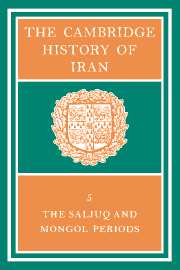Book contents
- Frontmatter
- 1 THE POLITICAL AND DYNASTIC HISTORY OF THE IRANIAN WORLD (A.D. 1000–1217)
- 2 THE INTERNAL STRUCTURE OF THE SALJUQ EMPIRE
- 3 RELIGION IN THE SALJUQ PERIOD
- 4 DYNASTIC AND POLITICAL HISTORY OF THE IL-KHĀNS
- 5 THE ISMĀ‘ĪLĪ STATE
- 6 THE SOCIO-ECONOMIC CONDITION OF IRAN UNDER THE ĪL-KHĀNS
- 7 RELIGION UNDER THE MONGOLS
- 8 POETS AND PROSE WRITERS OF THE LATE SALJUQ AND MONGOL PERIODS
- 9 THE VISUAL ARTS, 1050–1350
- 10 THE EXACT SCIENCES IN IRAN UNDER THE SALJUQS AND MONGOLS
- Bibliography
- Index
- Plate section
- References
1 - THE POLITICAL AND DYNASTIC HISTORY OF THE IRANIAN WORLD (A.D. 1000–1217)
Published online by Cambridge University Press: 28 March 2008
- Frontmatter
- 1 THE POLITICAL AND DYNASTIC HISTORY OF THE IRANIAN WORLD (A.D. 1000–1217)
- 2 THE INTERNAL STRUCTURE OF THE SALJUQ EMPIRE
- 3 RELIGION IN THE SALJUQ PERIOD
- 4 DYNASTIC AND POLITICAL HISTORY OF THE IL-KHĀNS
- 5 THE ISMĀ‘ĪLĪ STATE
- 6 THE SOCIO-ECONOMIC CONDITION OF IRAN UNDER THE ĪL-KHĀNS
- 7 RELIGION UNDER THE MONGOLS
- 8 POETS AND PROSE WRITERS OF THE LATE SALJUQ AND MONGOL PERIODS
- 9 THE VISUAL ARTS, 1050–1350
- 10 THE EXACT SCIENCES IN IRAN UNDER THE SALJUQS AND MONGOLS
- Bibliography
- Index
- Plate section
- References
Summary
THE EASTERN IRANIAN WORLD ON THE EVE OF THE TURKISH INVASIONS
For nearly a thousand years—indeed, until our own century—Iran has generally been ruled by non-Persian dynasties, usually Turkish but sometimes Mongol or Kurdish. This domination at the highesh level has had less effect on Iranian national psycyhology and literary consciousness than might be expected, for all of the alien ruling dynasties have come from races of low cultural development, and thus they have lacked the administrative expertise necessary for ruling a land of ancient settlement and civilzation. Whether consciously or unconsciously, they have adopted Iranian culture at their courts, and they have been compelled to employ Iranian officals to adminster the country and collect the taxes.
The first such alien rules were the Saljuq Turks, who appeared in the Iranian world in the first half of the 5th/11th century. For them as well as for their successors, the process of assimilation to the indigenous culture and practices of Persia was not uncongenial, because they were able to draw on the country's ancient traditions of exalted monarchie power and submissiveness by the people. Moreover, in these traditions kingly authority was identified with divine authority, which helped the dynasties to rise above their tribal origins. The Saljuqs has originated as chieftains of nomadic bands in the Central Asain Stepps. Their powers and ambitions often hedged about by a complex of traditional tribal rights and customs, the steppe leaders were little more than primi inter pares amongst the heads of all the prominent trial families. With their entry into the Iranian world, the Saljugs and their successors found the instruments at hand with which to make themselves, if they so desired, despots of the traditional Persian Stamp: these instruments were a settled administration, a steady revenue from taxation, and usually a personal guard and standing army.
Keywords
- Type
- Chapter
- Information
- The Cambridge History of Iran , pp. 1 - 202Publisher: Cambridge University PressPrint publication year: 1968
References
- 15
- Cited by



